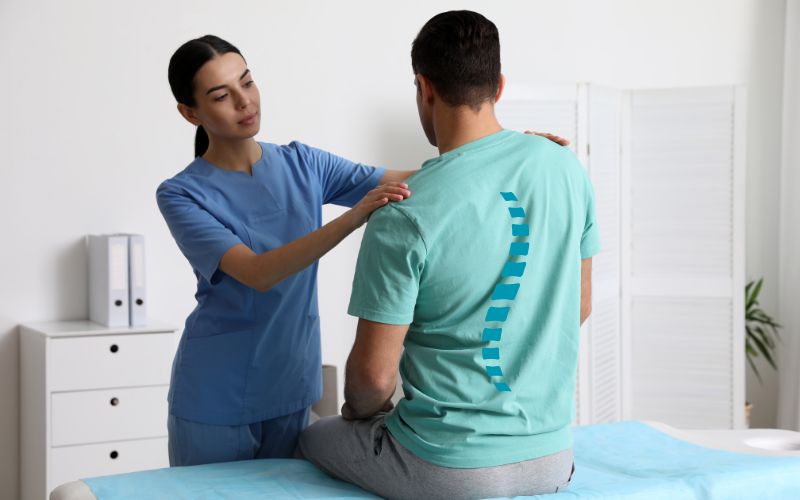A diagnosis of scoliosis, or an abnormal curvature of the spine, can lead to many questions about appropriate scoliosis treatment in Delhi. Most often, it is diagnosed in childhood and adolescence, which is best time to prevent any possible complications before reaching adulthood. If not treated on time, scoliosis causes serious problems. Timely intervention through braces or surgery can prevent or reduce the consequences. Fortunately, the majority of people with scoliosis seek immediate medical care. It minimises the symptoms and reduces complications related to ageing. Dr. Nagesh Chandra, a spine specialist in Dwarka, Delhi, explains the complications of scoliosis
Causes of Scoliosis Complications
Several things may be responsible for the development of scoliosis complications in adults. Knowing these elements helps to take measures and avoid more problems.
- Undiagnosed Scoliosis: Some people have scoliosis without even being aware of it. Without a diagnosis, they lose out on the chance to be treated, It could greatly improve their quality of life.
- Neglecting Mild Scoliosis: Mild scoliosis is barely noticeable. There are no present symptoms. This indifference may cause further issues when the spine degrades with time.
- Surgical Complications: Surgery especially spinal fusion can have long-term side effects. They can be low mobility and chronic pain.
How Scoliosis is Affected by Aging?
The ageing process worsens general health status and the connective tissue’s integrity. As adults age, body changes increase the curvature of the back spine when scoliosis is present. The degree of severity of your curve alongside your overall health will determine when complications finally set in.
- Loss of Connective Tissue Elasticity: As tissue becomes less elastic with age, this results in stiffness and more injury risks.
- Joint Wear and Tear: Scoliosis can bring accelerated arthritis characterized by pain and stiffness in a joint.
- Loss of Water Retention: As long as one ages, their spine disc height will disappear gradually, which in turn could lead to spinal stenosis.
- Spinal Stenosis: Scoliosis increases spinal stenosis, as spaces around the spinal cord and nerves become tinier.
Complications Occurring with Untreated or Poorly Managed Scoliosis
Untreated spinal curves can lead to severe complications. There are two main objectives of scoliosis treatment, the first being to stop the worsening of the curvature of the spine. The absence of thorough care and constant checkups may result in the progress of the disorder. Severe scoliosis can lead to some extent to produce the following problems.
- Stenosis: Decompression of the spine or nerve spaces can occur, particularly at the lumbar spine. This might result in numbness, tingling, shooting pain, and also weakness. The most severe cases will preferably receive medical treatment immediately.
- Poor Breathing Mechanics: A humped back can move the rib cage off the centre, making inhalation limited, rigid, and painful, as well as leading to shortness of breath. The diaphragm may have difficulty moving and the muscles in the neck may strain.
- Poor Gait Mechanics: Spinal curvature determines the pelvis alignment as well as its leg length and, consequently, creates a leg length difference. This imbalance may eventually give rise to joint pain and poor biomechanics, all of which affect your lower body as well as back, pelvis, hips, and knee.
- Compromised Organ Function: Severe scoliosis causes an increase in abdominal pressure while causing chronic poor posture. This can be characterized by extreme cases leading to heart disease, heart failure, and pneumonia.
How to Reduce the Risk of Age-Related Complications?
Scoliois treatment helps to prevent prolongation at any age. Treatment should not be discontinued because it can stop the degeneration of the spine and help manage symptoms professionally. Early and constant treatment can manage or even reverse the spinal curvature without surgical invasions. Below are a few treatment options you can follow:
- Chiropractic Care for Scoliosis: Non-traumatic interventions such as chiropractic care could physically manage scoliosis more holistically. The advanced treatments and certified practitioners help manage scoliosis in adolescents and adults through Chiropractic care.
- Posture Training: In some centres, 3D picture technology is used to correct the spinal column position and posture. Proper education, mirror imaging, corrective exercise and other techniques are used as a means to reverse the spinal curvature. In the case of moderate or severe conditions, bracing can enhance and accelerate recovery.
- Bracing: Using a brace provides a unique 3D spinal support helping the body to find the natural alignment while maintaining movement. It provides adequate support and manages the scoliosis deformity. Alternatively, based on your individual needs, you will wear the brace either periodically, constantly, or while sleeping.
The treatment options mentioned above are common options from which your neurosurgeon or spine doctor in Delhi will choose according to your condition. Hence, you need to consult him/her for this.






Comments